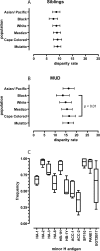Phenotype frequencies of autosomal minor histocompatibility antigens display significant differences among populations
- PMID: 17604453
- PMCID: PMC1904367
- DOI: 10.1371/journal.pgen.0030103
Phenotype frequencies of autosomal minor histocompatibility antigens display significant differences among populations
Abstract
Minor histocompatibility (H) antigens are allogeneic target molecules having significant roles in alloimmune responses after human leukocyte antigen-matched solid organ and stem cell transplantation (SCT). Minor H antigens are instrumental in the processes of transplant rejection, graft-versus-host disease, and in the curative graft-versus-tumor effect of SCT. The latter characteristic enabled the current application of selected minor H antigens in clinical immunotherapeutic SCT protocols. No information exists on the global phenotypic distribution of the currently identified minor H antigens. Therefore, an estimation of their overall impact in human leukocyte antigen-matched solid organ and SCT in the major ethnic populations is still lacking. For the first time, a worldwide phenotype frequency analysis of ten autosomal minor H antigens was executed by 31 laboratories and comprised 2,685 randomly selected individuals from six major ethnic populations. Significant differences in minor H antigen frequencies were observed between the ethnic populations, some of which appeared to be geographically correlated.
Conflict of interest statement
Competing interests. The authors have declared that no competing interests exist.
Figures


Similar articles
-
Minor histocompatibility antigens: allo target molecules for tumor-specific immunotherapy.Cancer J. 2004 Jan-Feb;10(1):1-7. doi: 10.1097/00130404-200401000-00001. Cancer J. 2004. PMID: 15000488 Review.
-
Minor histocompatibility antigen typing by DNA sequencing for clinical practice in hematopoietic stem-cell transplantation.Methods Mol Biol. 2012;882:509-30. doi: 10.1007/978-1-61779-842-9_29. Methods Mol Biol. 2012. PMID: 22665253
-
Minor histocompatibility antigens: past, present, and future.Tissue Antigens. 2014 Oct;84(4):374-60. doi: 10.1111/tan.12445. Tissue Antigens. 2014. PMID: 25262921 Review.
-
Frequencies of 10 autosomal minor histocompatibility antigens in Korean population and estimated disparities in unrelated hematopoietic stem cell transplantation.Tissue Antigens. 2012 Jan;79(1):42-9. doi: 10.1111/j.1399-0039.2011.01810.x. Tissue Antigens. 2012. PMID: 22150369 Clinical Trial.
-
The relevance of minor histocompatibility antigens in solid organ transplantation.Curr Opin Organ Transplant. 2009 Aug;14(4):419-25. doi: 10.1097/MOT.0b013e32832d399c. Curr Opin Organ Transplant. 2009. PMID: 19444105 Review.
Cited by
-
Immunological barriers to stem-cell based cardiac repair.Stem Cell Rev Rep. 2011 Jun;7(2):315-25. doi: 10.1007/s12015-010-9202-x. Stem Cell Rev Rep. 2011. PMID: 21086071 Free PMC article. Review.
-
Adoptive transfer of unselected or leukemia-reactive T-cells in the treatment of relapse following allogeneic hematopoietic cell transplantation.Semin Immunol. 2010 Jun;22(3):162-72. doi: 10.1016/j.smim.2010.02.003. Epub 2010 May 26. Semin Immunol. 2010. PMID: 20537908 Free PMC article. Review.
-
HSPVdb--the Human Short Peptide Variation Database for improved mass spectrometry-based detection of polymorphic HLA-ligands.Immunogenetics. 2011 Mar;63(3):143-53. doi: 10.1007/s00251-010-0497-1. Epub 2010 Dec 2. Immunogenetics. 2011. PMID: 21125265 Free PMC article.
-
Impact of genomic polymorphisms on the repertoire of human MHC class I-associated peptides.Nat Commun. 2014 Apr 9;5:3600. doi: 10.1038/ncomms4600. Nat Commun. 2014. PMID: 24714562 Free PMC article.
-
HapMap scanning of novel human minor histocompatibility antigens.Blood. 2009 May 21;113(21):5041-8. doi: 10.1182/blood-2008-07-171678. Epub 2008 Sep 22. Blood. 2009. PMID: 18809759 Free PMC article.
References
-
- Simpson E, Roopenian D, Goulmy E. Much ado about minor histocompatibility antigens. Immunol Today. 1998;19:108–112. - PubMed
-
- Goulmy E. Human minor histocompatibility antigens. Curr Opin Immunol. 1996;8:75–81. - PubMed
-
- Goulmy E, Persijn G, Blokland E, D'Amaro J, van Rood JJ. Cell-mediated lympholysis studies in renal allograft recipients. Transplantation. 1981;31:210–217. - PubMed
-
- Spierings E, Wieles B, Goulmy E. Minor histocompatibility antigens–big in tumour therapy. Trends Immunol. 2004;25:56–60. - PubMed
Publication types
MeSH terms
Substances
Grants and funding
LinkOut - more resources
Full Text Sources
Other Literature Sources

